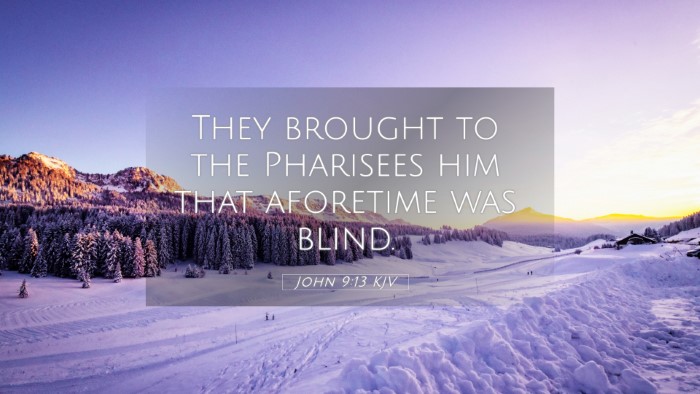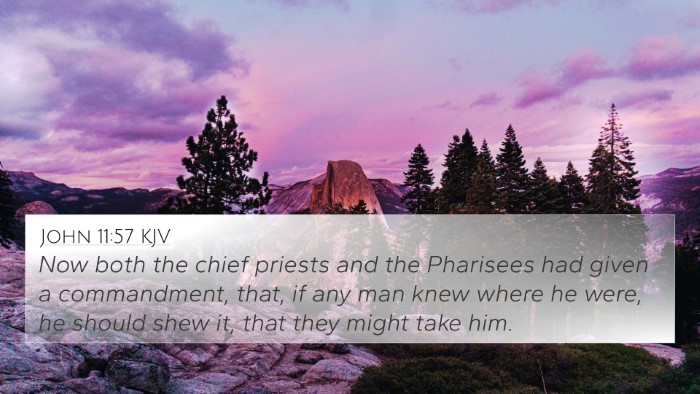Understanding John 9:13
John 9:13 states, “They brought to the Pharisees him that aforetime was blind.” This verse comes from the narrative of Jesus healing a man who was born blind. The act of healing not only serves as a miracle demonstrating Jesus’ divine authority but also reflects the escalating tensions between Jesus and the religious leaders of the time. The following analysis draws insights from public domain commentaries to explore the meaning and implications of this verse.
Contextual Background
The healing of the blind man is significant within the broader context of John's Gospel. Jesus often heals individuals in ways that challenge societal and religious norms. This healing, in particular, raises questions about the nature of sin, faith, and authority, setting the stage for a conflict with the Pharisees, who represented the religious establishment.
Commentary Insights
-
Matthew Henry:
Henry emphasizes that the healing of the blind man illustrates the power of Jesus to open both physical and spiritual eyes. He notes that the act of bringing the healed man to the Pharisees was an inference of a desire for verification of his healing, which ultimately leads to a confrontation about Jesus’ identity and authority.
-
Albert Barnes:
Barnes highlights the theological implications of the event, suggesting that the healing signifies more than just physical restoration; it serves as a metaphor for spiritual awakening. By bringing the man to the Pharisees, the witnesses aim to authenticate the miracle, but the Pharisees' response reveals their spiritual blindness.
-
Adam Clarke:
Clarke notes that the text illustrates a conflict between the authority of Jesus and the established religious leaders. The Pharisees symbolize a system that is resistant to acknowledging the workings of God through Christ. The incident prompts discussions about faith, doctrine, and the response required from those who witness miraculous events.
Key Themes and Messages
- Spiritual vs. Physical Blindness: The physical healing of the blind man contrasts with the spiritual blindness of the Pharisees, suggesting that true sight comes from faith in Jesus.
- The Authority of Jesus: The healing prompts questions about who Jesus is and the source of His authority, emphasizing the conflict between divine revelation and human tradition.
- The Role of Witnesses: The act of bringing the man to the Pharisees portrays the importance of testimony and the challenges faced by those who bear witness to God's work.
Cross-References
This verse can be connected to various other scriptures, enhancing the understanding through thematic Bible verse connections:
- John 9:1-7: The account of the healing itself.
- Isaiah 35:5-6: Prophecies about the healing of the blind, pointing to the Messianic age.
- John 8:12: Jesus as the light of the world that brings understanding and life.
- Matthew 15:14: The blind leading the blind, illustrating the danger of spiritual ignorance.
- John 3:19-21: The rejection of the light by those who love darkness.
- Luke 14:21: The call to invite and acknowledge those marginalized by society.
- 2 Corinthians 4:4: The god of this world blinding the minds of unbelievers.
Practical Applications
This verse encourages believers to consider their own spiritual clarity and the willingness to testify about God's work in their lives. Here are some practical thoughts for application:
- Reflect on areas of personal blindness or misunderstanding regarding faith.
- Seek to actively share personal testimonies of God’s work in your life.
- Engage with scripture to deepen understanding and connection with Christ.
Conclusion
John 9:13 is a powerful reminder of the transformation that occurs through faith in Jesus. It challenges readers to examine the interplay between sight and blindness, both physically and spiritually, highlighting the essential role of faith and testimony in the journey of belief. Understanding this verse through the lens of cross-referenced scriptures enhances our grasp of Biblical themes, and aids in developing a more comprehensive view of how different scriptural pieces connect and inform one another.
Further Study and Resources
For those interested in diving deeper, tools for Bible cross-referencing can enhance study practices. Utilizing a Bible concordance or cross-reference guide assists in identifying connections between Old and New Testament scriptures, enabling a robust understanding of how themes recur and evolve within the Biblical narrative.







